more about thimbles





Victorian Pictorial (‘castle’), commemorative and souvenir thimbles 3
Magdalena and William Isbister.
Other destinations
Other tourist destinations for the travelling Victorians included Dover Castle (Fig 47), Windsor Castle (Fig 48), Kenilworth Castle (Fig 49), Exeter Cathedral (Fig 50), Lichfield Cathedral (Fig 51), Lincoln Cathederal (Fig 52), Newstead and Tintern Abbeys (Fig 53), Abbotsford House (Fig 54) and an unknown cathedral (probably Winchester (Fig 55)), all of which are represented on silver souvenir thimbles which were made during the earlier part of the Queens reign.
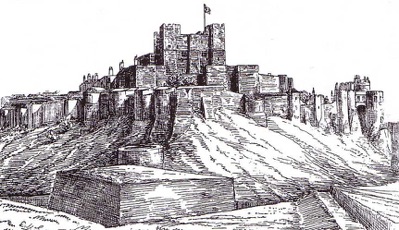
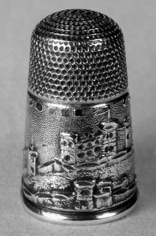
Fig 47
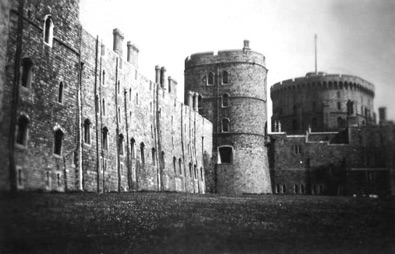
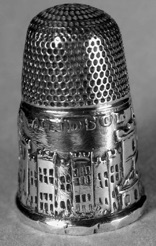
Fig 48
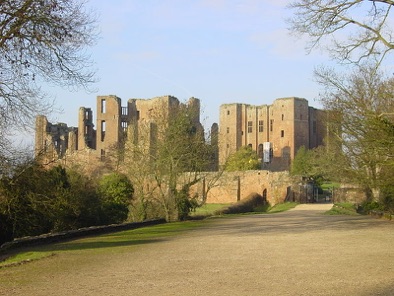
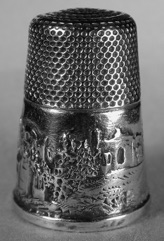
Fig 49
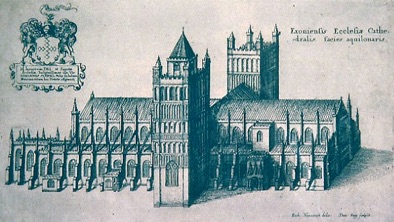
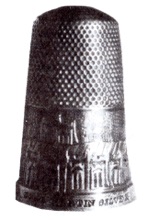
Fig 50
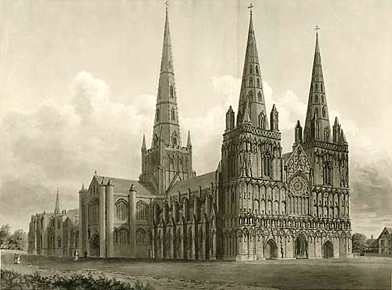
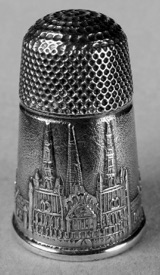
Fig 51
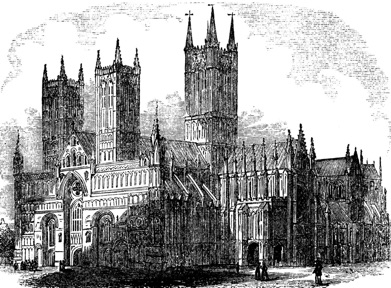
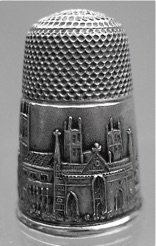
Fig 52
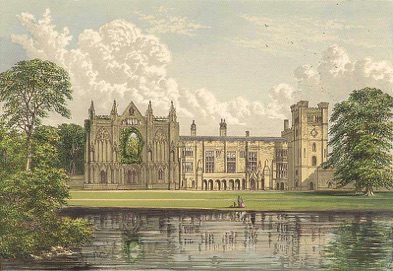
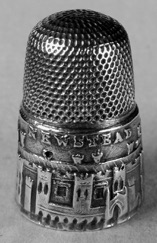
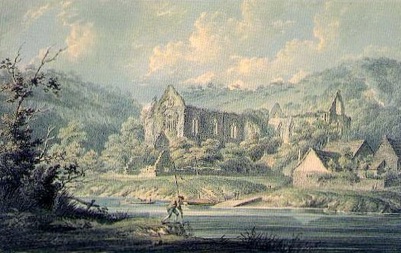
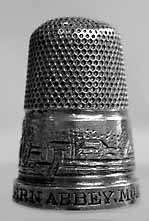
Fig 53
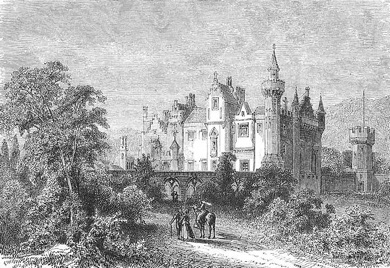
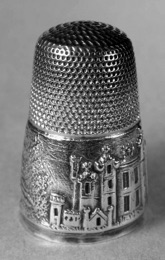
Fig 54
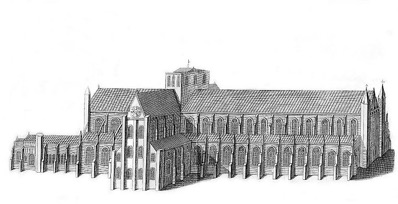
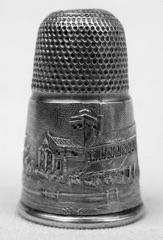
Fig 55
The thimble depicting Kenilworth Castle (Fig 49) has a maker’s mark – ‘T & P’ – for Taylor and Perry of Birmingham. It is thought to have been made in the 1840s. The thimble with a picture of Exeter Cathedral (Fig 50) has ‘ Comb Martin Silver’ inscribed around its rim. The silver and lead mines at Combe Martin were very old but had to close in 1848. It is known that items made prior to closure were marked in this way (3). There is no other marking on the thimble.
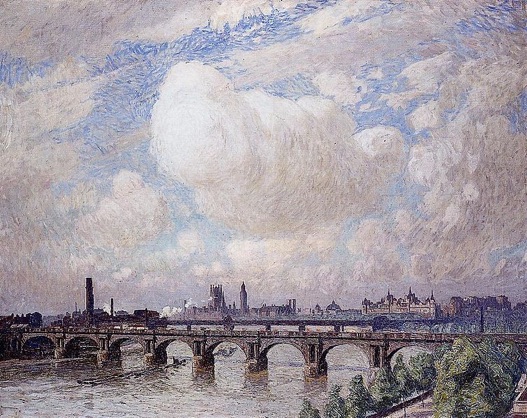

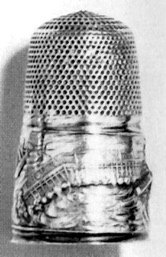
Fig 56
Two further souvenir thimbles (Fig 56), made in the same two-part way depict the Waterloo Bridge and an unknown ‘sea wall’. The makers of these thimbles are unknown.
Less elaborate souvenir thimbles were made for Victorian travellers towards the end of the 19th century. These thimbles simply had a person’s name or a place name applied to the ribbed border (Fig 57, top row) in contrast to later souvenir thimbles where the place name was stamped or milled into the border (Figs 44, 57, bottom).

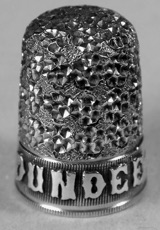
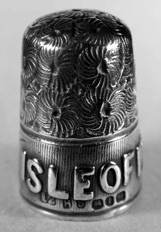
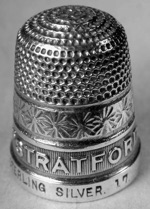
Fig 57
A rather curious example of one of these souvenir thimbles is the ‘Mona’ thimble (Fig 58). Made by John Thompson of London in 1897, the thimble has ‘Mona’ in letters on one side of the border whilst on the other side there is the three-legged symbol (triskellion) of the Isle of Man. Mona is the name given to the island of Anglesey and not the Isle of Man so it would seem that Thompson had his islands mixed up!
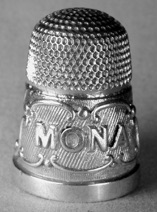
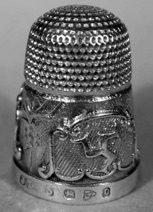
Fig 58
Other Victorian place souvenir thimbles were made in both brass and porcelain.
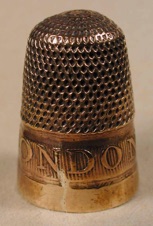

Fig 59 Fig 60
The maker of the brass thimble is unknown (Fig 59). The porcelain, souvenir of Worcester, transfer printed, thimble (Fig 60) was made by Locke and Co. of Worcester between 1870 and 1890.
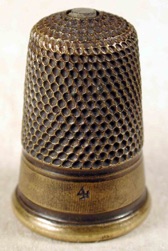

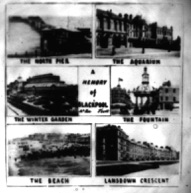
Fig 61 Fig 62
In about 1880 William Pursall of Birmingham patented a simple brass souvenir thimble with a ‘peep’ in the top (Fig 61). Peeps (Fig 62) made in France by Dagron & Cie, and imported by McKee of Dublin, were incorporated into plain brass thimbles, but whether Pursall actually made the thimble illustrated above remains in doubt (4). The Fourth Bridge, built and opened during the reign of Queen Victoria, was a very popular theme. Some pictures are now sharper than others!
Expositions
During the reign of Queen Victoria there were three major International Expositions held within the United Kingdom of Great Britain and Ireland.
‘The Great Exhibition of the Works of Industry of all Nations’ or Great Exhibition (Crystal Palace Exhibition)
The Great Exhibition of the Works of Industry of all Nations was held in Hyde Park, London from 1 May to 15 October 1851 in a specially constructed glass and cast iron building. It became known as the Crystal Palace (Fig 63) and was designed by Joseph Caxton. The Great Exhibition was the first of a series of World Exhibitions of industry and culture to become a popular 19th century feature. Prince Albert helped to organize and promote the exhibition and it was a celebration of industrial design and technology from all over the commonwealth and the rest of the world. There were over 13,000 exhibits and approximately 6,200,000 visitors attended the exhibition (Fig 64).
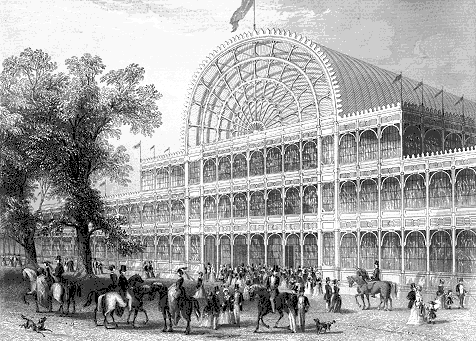
Fig 63
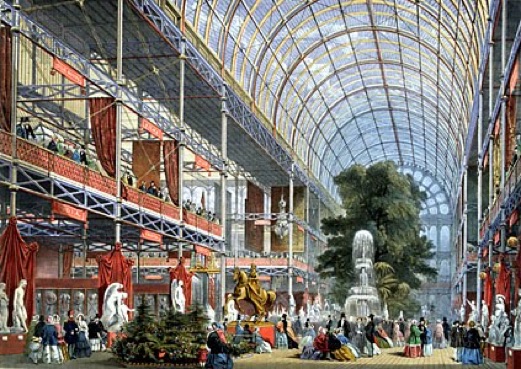
Fig 64
Several thimbles were made to commemorate the exhibition. In particular Alfred Taylor of Great Howard Street, Birmingham registered (design number 73871) a design which shows the Crystal Palace (Fig 63) and has the text ‘Exhibition of All Nations 1851’ above the pictorial border. The thimble bears the diamond registration mark and from this and the registration document the name of the maker can be ascertained (5). Taylor did not add his own registered mark to this thimble (Fig 65).



Fig 65 Fig 66
Another thimble commemorating the exhibition (Fig 66) has ‘Great Exhibition Hyde Park 1851’ stamped on the rim. The maker is unknown.
After the exhibition closed the Crystal Palace was moved to Sydenham Hill in South London and another thimble was made to commemorate the move (Fig 67). In addition to an image of the Crystal Palace the rim is inscribed ‘Crystal Palace Sydenham’.

Fig 67
One further thimble may be associated with the Great Exhibition. The Ionian Islands were under the protection of the British Crown and the Governor, Lord Seaton, exhibited a thimble at the Great Exhibition in 1851. This thimble had a plain dimpled top with an applied border that depicted the arms of the seven islands of the Ionian group (Fig 68).


Fig 68
On November 30th 1936 the Crystal Palace was destroyed by fire.
Great Industrial Exhibition 1853
The Great Industrial Exhibition of 1853 was held in Dublin, Ireland. It was the largest exhibition to have been held in Ireland and was funded by William Dargan, an engineer and ‘father of the Irish railways’. It was hoped that through the exhibition the industrial revolution could be brought to Ireland but the people of Ireland seemed not to be able to relate to much of the technology on display (overall attendance 1,156,232). The exhibition thus made a big financial loss and ruined Dargan. Visitors to the exhibition were more impressed by the building than the exhibits contained there in (Figs 69, 70).
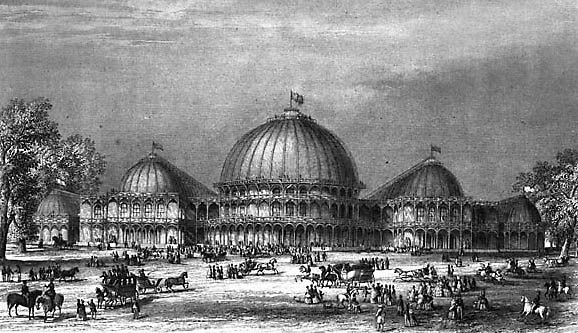
Fig 69

Fig 70
A thimble was made to commemorate this exhibition by an unknown maker. It depicted the exhibition building around the border and was imprinted ‘Dublin 1853’ on the rim (Fig 71).

Fig 71
The International of 1862, or Great London Exposition
The exhibition was held from May 1st to November 1st beside the Royal Horticultural Society Gardens in South Kensington, London. The main façade was along Cromwell Road (Fig 72) and like the 1851 exhibition celebrated industry, technology and the fine arts. The site is now occupied by the Natural History and Science Museums but little of the original building remains. Over six million people attended the exhibition and unlike the Dublin Exhibition the London exhibition made a good profit.

Fig 72 © Science & Society Picture Library
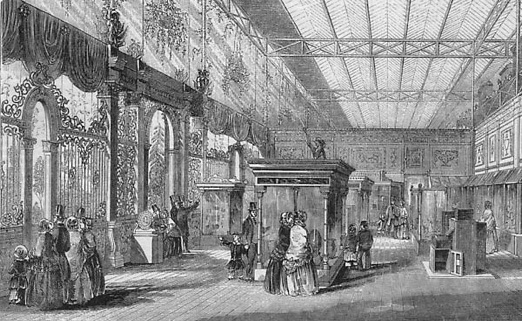
Fig 73
Peyton and Iles exhibited at the exhibition (6) in the Birmingham Court (Fig 73) where they showed hooks and eyes and enamel-lined thimbles. It is probable that they sold inexpensive souvenir thimbles too (Fig 74).



Fig 74 Fig 75 Fig 76
This souvenir set contained a silver cased thimble, complete with the Iles mark (Fig 75), and an ‘ivorine’ finger guard (Fig 14).
Two silver thimbles are associated with the 1862 exhibition (4). One was made by Henry Griffith of Birmingham although it does not bear his mark. The design (139132) was registered on the 26.3.1861. The thimble depicts the Cromwell Road façade (Fig 72) and bears the inscription ‘International Exhibition 1862’ (Fig 76). It does not bear the diamond mark but is the same as the thimble shown in the original design document.


Fig 76
The second thimble does bear a design diamond mark and corresponds to the design (143397) registered by George Cartwright and Horace Woodward of Birmingham on the 12.9.1861 (Fig 77). The border is decorated with an image of the exhibition hall, which seems more like the Crystal Palace than the Cromwell Road building, but bears the words ‘International Exhibition 1862’ around the rim.


Fig 77
It is not known whether either Griffith or Cartwright and Woodward had exhibits in the exhibition but clearly since the designs were registered in 1861 they planned to sell the thimbles as either souvenirs of the exhibition or as thimbles to commemorate the exhibition. It is interesting to note that these two thimbles depicting buildings were the only ‘building thimbles’ to have had their design registered.
References
3. Holmes EF. Thimble Notes and Queries 1990; 7: 19.
4. Scott J. The Mystery of the ‘Pursall’ Thimble.. in ‘Stanhopes – a closer view’. J Scott, 2003. pp. 58-60.
5. Spicer N, Burn DP. British Registered Design Thimbles. 2003: pp. 5-6.
6. Spicer N. Iles- A family of thimble makers. pp. 7-8
Holmes: ‘Commemorative Thimbles' pp. 173, 'Souvenir Thimbles' pp. 182.
Researched and published in 2002/11
Copyright@2011. All Rights Reserved
Magdalena and William Isbister, Moosbach, Germany
Navigation
